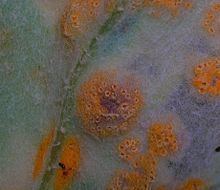Kingdom Fungi Phylum Basidiomycota Order Rust | Family Pucciniastraceae Scientific name Puccinia poarum Rank Species Subclass Incertae sedis | |
 | ||
Similar Puccinia, Rust, Puccinia sessilis, Coleosporium tussilaginis, Puccinia menthae | ||
Puccinia poarum, Coltsfoot Rust gall or Meadow Grass Rust is a plant pathogen. This fungal parasite forms a bright yellow gall, 1–2 cm across, on the underside of leaves of the Coltsfoot, Tussilago farfara and infects, but does not gall grasses of the poaceae family.
Contents
Characteristics
This yellow gall consists of relatively large and circular raised yellow or orange-red spots on the underside of the leaf, often with a purple margin and sometimes a central hole. The cup structures on the lower surface are relatively few in number (20-30). The upper surface of the leaf shows a yellow ring and no swelling. The rust has distinctive reproductive structures (aecia and spermogonia), present. The rust is necrophytic, a term applied to a parasitic organism that obtains its nutrients from the dead cells and tissues of its host organism.
Identification
Coleosporium tussilaginis is a rust fungus with which P. poarum is sometimes confused. C. tussilaginis usually appears somewhat later in the season and tends, not being a gall, to be spread all over the leaf rather than forming the discrete circular clusters typical of P. poarum; it is also less obvious on the upper leaf surface and lacks the purple margin with the central hole characteristic of the gall.
P. poarum is found on at least seventy plant hosts.
Life-cycle
Peter Nielsen was the first to describe the heteroecious life-cycle of this fungus; it's aecial or sexual phase host is the Coltsfoot, a member of the Asteraceae, spread by airborne spores; its telial or asexual host phase are members of the grass family, the Poaceae.
Heteroecious organisms are those that require two distinct and distantly related hosts (alternate hosts).
Distribution
In the United Kingdom it is locally common and widely distributed. Northern hemisphere to South America.
